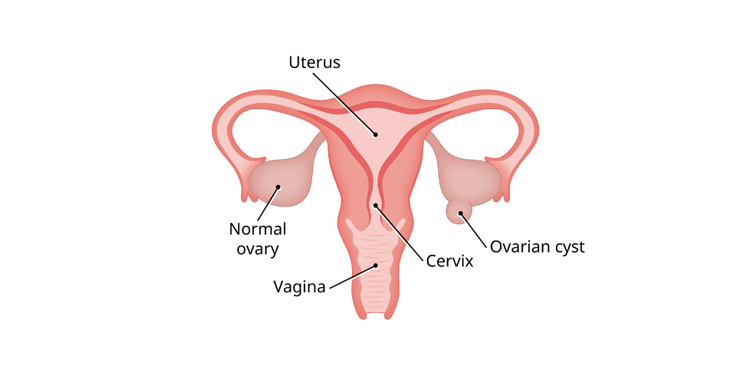
What is a Cyst?
A cyst is a sac formed from membrane tissue and containing fluids, air, semisolid materials, or other substances. Cysts can appear in various parts of the body, including under the skin.
Symptoms of a Cyst
The main symptom is a lump that grows in specific parts of the body, depending on the type experienced.
Lumps can grow on the face, neck, chest, back, scalp, palms, and soles of the feet.
However, some may grow inside the body, so the development of lumps may not be easily felt, such as in the breasts or ovaries.
Cysts have very slow growth and development. Additionally, they usually do not cause pain unless they become infected.
Here are signs that a cyst is infected:
- Discharge of blood or foul-smelling pus from the lump.
- Redness in the surrounding skin area.
- Infection causing pain.
- Stiffness or numbness, especially in the area where the cyst is growing.
- Nausea and vomiting.
- Fever.
- Dizziness.
Aside from infection, this condition can also cause discomfort.
When a cyst becomes very large, it can compress nerves or blood vessels, grow in sensitive areas, or affect organ function.
Causes of a Cyst
Here are things that can trigger or worsen a cyst:
- Genetic conditions.
- Tumors.
- Infections.
- Embryonic development abnormalities.
- Cell defects.
- Chronic inflammatory conditions.
- Blockages in the body’s ducts.
- Parasites.
- Injuries.
Risk Factors for a Cyst
Here are some triggering factors to be aware of:
-
Age
According to the U.S. National Library of Medicine (NLM), women between puberty and menopause have the highest risk of developing ovarian cysts.
This is because during this time, women still experience menstrual periods.
When women menstruate, fluid-filled lumps in the ovaries can form.
This is not a problem as long as the ovarian lump resolves on its own, does not enlarge, and does not cause symptoms.
Ovarian cyst-causing conditions rarely occur in women after menopause.
However, women who have entered menopause and have fluid-filled lumps in their ovaries are at higher risk of ovarian cancer.
-
Polycystic Ovary Syndrome (PCOS)
Women with polycystic ovary syndrome have a higher risk of ovarian cysts.
Polycystic ovary syndrome occurs when the body does not produce enough hormones for the follicles in the ovaries to release eggs.
As a result, follicular lumps form. Polycystic ovary syndrome can also disrupt hormone production in women, leading to many problems.
-
Endometriosis
Endometriosis occurs when parts of the tissue lining the uterus (endometrium) form outside the uterus, such as in the fallopian tubes, ovaries, bladder, large intestine, vagina, or rectum.
Sometimes, blood-filled sacs (lumps/fibroids) form in this tissue. The filled sacs formed by endometriosis are called endometriomas.
These lumps can cause pain during intercourse and menstruation.
-
Fertility drugs
Fertility drugs are usually used to help ovulation (release of eggs) such as gonadotropins, clomiphene citrate, or letrozole.
This is because they can affect the hormone balance in the body.
The use of fertility drugs can also increase the risk of ovarian cysts, often of the functional type.
The use of these drugs can lead to the formation of this condition in large numbers and sizes in the ovaries.
This condition is called ovarian hyperstimulation syndrome.
-
Chemotherapy with tamoxifen
Women with breast cancer who have undergone chemotherapy with tamoxifen have a higher risk of ovarian cysts.
Tamoxifen can cause cysts to form in the ovaries. However, these fluid-filled lumps may disappear after treatment ends.
Diagnosing a Cyst
Doctors can diagnose by performing a physical examination of the lump.
However, to confirm the diagnosis, doctors may need to perform further tests, such as:
- Imaging tests. Doctors may perform ultrasound, CT scans, or MRI, especially if the lump is not visible directly (for example, ovarian cysts). Imaging tests are done to see the contents of the lump and whether the lump is cancerous.
- Biopsy. Biopsy involves taking a tissue sample to be examined in the laboratory. Biopsy will help the doctor determine if this condition is cancerous.
Treating a Cyst
Cysts can disappear on their own without treatment. Patients can expedite the healing process by using warm compresses.
However, do not attempt to rupture them, as this can cause infection.
If the cyst does not disappear, visit a specialist doctor for medical treatment.
Doctors can remove cysts using the following methods:
- Surgical removal, if aspiration is unsuccessful.
- Injecting corticosteroids to reduce inflammation.
- Puncturing the cyst with a needle and performing fluid aspiration.
Cyst Complications
Enlarged cysts can cause discomfort to the patient.
Therefore, it is advisable to undergo an examination immediately if experiencing various health complaints related to the appearance of this condition.
Preventing Cysts
Although generally not preventable, some types can be avoided.
For example, chalazion can be prevented by cleaning the eyelids with a gentle cleanser.
Meanwhile, pilonidal cysts can be prevented by keeping the skin dry and clean and avoiding prolonged sitting.
Women with ovarian cysts can prevent new cysts from forming by taking birth control pills.
When to See a Doctor?
If you experience its symptoms, immediately discuss with a doctor to get the right diagnosis and treatment.




